View current page
...more recent posts
Don't know if this video, opening at Momenta Art this Friday, December 17, 6-9 pm, is good, but the description from the press release cracks me up:
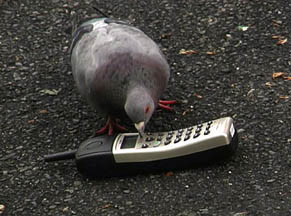
"Lisa DiLillo’s video and photographic work focuses on the peculiar interactions that take place between human constructs and other life forms. In her video piece This Call May be Monitored, a segment of a larger body of work entitled "Encounters," a group of pigeons gather around a lost cell phone in an urban park. As they randomly peck at the keys, they inadvertently dial a corporation that employs a voice recognition system. This results in a series of misinterpretations and technological cul-de-sacs. The fleeting sense of triumph over a technology meant to convenience the corporation over the individual quickly dissipates as the viewer recognizes that the corporation itself is not affected by this encounter whatsoever."
The description of the other artist's show is Marxism 101: "Exquisitely crafted and making clear reference to post-minimalism, Simone Leigh questions the bourgeois strategy of that formalist movement, which favored materiality over cultural meaning. The titles of these works mirror this formal disconnect, referencing the “Cake Walk” dance that was adopted by white, southern society. The cake walk was actually created by slaves to mock the strut of their masters. But just as the slave masters did not care what the dance was meant to emulate, the essentialism of minimalist and post-minimalist masters did not take into account either the national origin of their raw materials or the ethnocentric grounding of many forms considered to be essential or aesthetically pure. By remaining conscious of the economic and social connotations of her sculptural forms, Leigh not only evokes an underlying history of colonialism, but she also reminds us of its presence in an art world that continues to coolly reject any reminders of the world outside of its self. [Actually the post-Minimalists, principally Eva Hesse and Richard Serra, were edging away from the "de-cultured," machine-tooled art of Judd, etc. towards what Robt. Atkins calls "the embellished" and what I'd additionally call "being-in-the-world." Hesse "feminized" machine-tooled art with disposable, organic elements, and Serra's first works were basically earthworks. I don't think any great artists, Minimal, post-Minimal, or even the AbEx'rs, were pure formalists. Only an idiot talks about art solely in terms of color, symmetry, etc.]
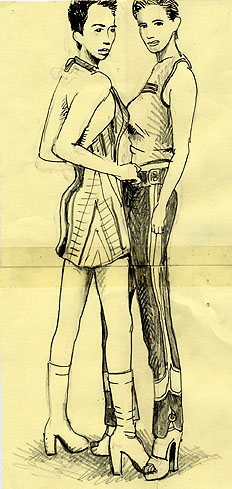
Those reading this weblog outside New York should know that people in this city hate Rudolph Giuliani. Before 9/11/01 he was a nudzh whose tenure was memorable mainly for the bullying of sidewalk vendors and people dancing in bars, and racism. His current standing derives from looking televisually calm on 9/11 while Bush flew cluelessly around the country--it's an act that played well outside the five boroughs but no one here was impressed, because we know what a camera hog he is. As Al Sharpton said shortly after that horrible day, "The people didn't come together because of the mayor, they came together because of the victims. They would have come together if Bozo had been mayor." (Some people thought that was "too much" at the time.)
So imagine a collective "aah" of pleasure this week as Giuliani's personal pick for Fatherland Security, Bernard Kerik, went down in flames amid a host of accusations of...irregularities. Here's what the New York Press said a few days ago, when it looked liked Kerik would sail through confirmation hearings with minimum press scrutiny:
But it needs to be said: Not only is Kerik unqualified for the Homeland Security post, the politics behind his candidacy are built upon a myth—the myth of Rudy Giuliani and 9/11. Sustaining this myth requires keeping a few facts from bubbling up the memory hole, such as: Rudy's headless chicken act on the morning of the attacks; his idiotic decision to place the city's emergency management center—and illegal fuel tanks—in WTC 7; his prompt melting of the wreckage, thus destroying the evidence from the biggest crime scene in American history; and his baffling negligence in preparing for a likely second attack on the towers following the Trade Center bombing of 1993, as evidenced by the lack of coordinated planning between agencies and widespread equipment dysfunction on 9/11.
The Rudy-9/11 myth is crucial to Kerik's nomination, because without this myth there is no Rudy the National Player, and without Rudy the National Player there is no nomination of brusque outsider Bernie Kerik to a major cabinet post in Washington. Rudy has always been upfront about his hand in Kerik's rise from pony-tailed narc to NYPD chief. And just as it was Rudy—and 9/11—that allowed Kerik to enrich himself in the terror biz, it was Rudy who put Kerik's name on President Bush's lips last week.
The following came in as a comment to an earlier post on Pierre Huyghe's "Annlee" project. I thought it was kind of dumb that Huyghe bought the rights to an anime character and then changed her physical appearance before making her available as "open source art." If the art dealt with branding why not use the brand you paid good money for?
I am a graduate student at NYU writing about Pierre Huyghe. [...] Considering how explicitly critical he is of the act of representing and defining, he sure is quick to outline what his work means. I recently attended his talk at the New School and fell asleep.I don't know enough about Huyghe to know if his "rap" over-determines his art. Possibly that happened with the Annlee project. But I only wrote about the premise and one writer's take on it, not the exhibit based on the premise.
The only Huyghe pieces I know well were the ones at the Guggenheim in 2002, the film of high-rise apartment building lights blinking on and off to a techno beat and the disco dance floor playing Satie. I liked the building piece, Les Grands Ensembles, 1994-2001, quite a bit and the music by Pan Sonic and Cédric Pigot particularly wowed (Pan Sonic rules). We probably don't need Huyghe informing us "These subsidized public projects ended up being an architectural and social failure, They were a corruption of Le Corbusier's social and architectural Modernist theory" but I don't mind knowing that. He even tells us what we see with our own eyes: "Without beginning or ending, the two low-income towers dialogue in a strange Morse code given by the light of their respective windows, a blinking existence." Which saved me having to write that.
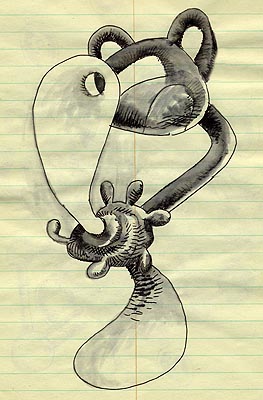
New track: "Taser Squad" [mp3 removed].
Dark, gloomy, bare-bones techno where the bolts pop off the synthesizer and the circuits audibly fail.
My complete musical works in .mp3 form are here (19 tracks since 1998!)
Housekeeping: my review of Susan Canning's "Paradise/Paradox" exhibit published in Sculpture last spring is posted in full text here. Also, the "selected critical writing" page has been revamped slightly, putting print publication, web-only writing, and interviews under separate headings. The criteria for "selection" were very exacting: basically anything I had in soft-copy form that didn't have to be retyped.
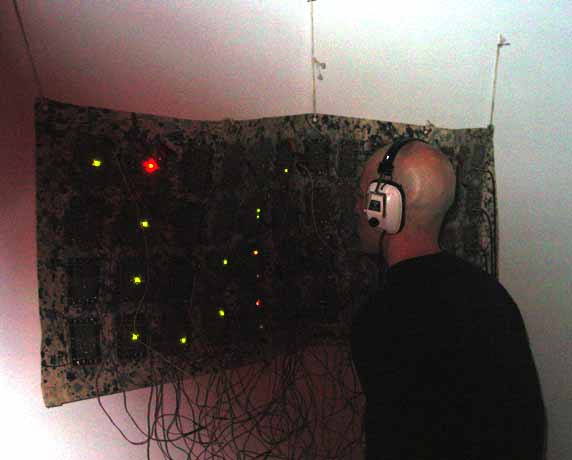
More on the circuit bending genre. The painterly and/or sculptural aspirations of benders can be problematic, especially if the result is sci fi cliche, but the physical aspect can be engaging, too. So we're looking for good examples of circuit bent pieces that are visually, musically, performatively tight. I've posted work by Peter Blasser (aka Peter B) before; above is another piece of his (I think it's his) that I photographed at the Shinth Tour at Deitch last year. It reminds me of Eva Hesse's Metronomic Irregularity II (below) only with a sound component: actually it's as if her work looked forward to a time when sound would complete the idea.
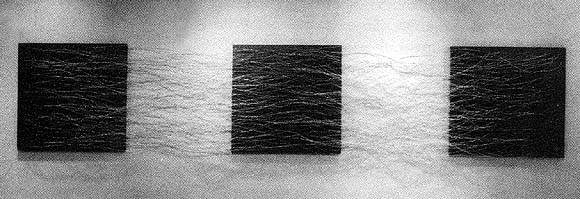
My memories of the Blasser piece are sketchy. I don't know what the circuit board/sound-producing module thingies are. The cloth is a paint-spattered rectangle of canvas that's like a parody of a bad Pollock, but the expressionism component is relevant, particularly in light of the Hesse, which has been described as an attempt to reconstitute Pollock in the vocabulary of '60s minimalism. The sound you hear through the headphones is the sublime product of random crisscrossing connections in the circuit field: chirping robotic crickets, but with pauses and subtleties making them slightly haunted and Eno-esque. The blinking lights were their ephemeral, firefly-droid cousins. I don't know if there was any programming involved in the routing of the signals, or if it was solely a product of hardwiring parts. I guess I don't really care. More detail about the piece would be appreciated.
UPDATE: via cory, a momus-sponsored page devoted to Peter Blasser's old band the Gongs. the mp3 doesn't work but great photo. also link to CD (don't know about availability).
